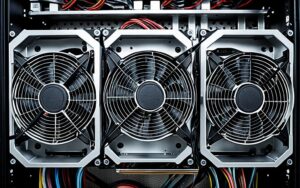Table of Contents
Is your computer leaving you in the cold with unexpected freezes? Well, most of us have been in this chilly predicament. A frozen PC is a common reason for users’ headaches around the globe. But cheer up! We’re here to help you unjam that frozen desktop of yours and arm you with the tools to ultimately repair the unresponsive PC.
In this article, we’ll determine the reasons for and explore the ways to fix your halted system, ranging from simple solutions suitable for everyone to more advanced ones reserved for true geeks. Now it’s time to buckle up and warm yourself up, as we’re on our way to address PC freezing issues head-on.
Why Is My PC Freezing?
Before jumping into solutions to resolve your frozen computer problem, let’s get a grasp on why your PC might be freezing up. Well, that’d be quite a list.
- Overheating: An excessive amount of heat can damage components and cause the system to freeze as a preventative measure.
- Software problems: Another common cause of PC freezes is software glitches, bugs, or conflicts, including operating system errors or improperly coded applications.
- Hardware problems: Faulty hardware, such as a failing hard drive or malfunctioning RAM module, can also be the reason for system instability and freezes.
- Driver errors: Corrupted, outdated, or incompatible device drivers can cause conflicts or instability within the system, occasionally resulting in system crashes and freezes.
- Malware or viruses: Viruses and other malicious software can interfere with system processes, consume resources, and affect its operations, leading to system freezes.
- Inadequate RAM: When a system struggles to allocate resources effectively, it may freeze. This may be caused by having an insufficient amount of RAM, which does not allow you to run multiple applications or tasks simultaneously.
- Too many background processes: When your PC is running a high number of background processes or applications simultaneously, this can overwhelm system resources, leading to freezes.
- Hardware incompatibility: Certain hardware configurations may be incompatible with each other, leading to conflicts or instability that can result in system freezes under certain conditions.
- Corrupted operating system: Damage to critical system files or the operating system itself can render your system unable to maintain normal operation, leading to overall instability and freezes.
- Power supply problems: Issues with the power supply unit (PSU), such as voltage spikes, insufficient power, or physical problems with the unit, can trigger power-related disruptions, affecting system operation and causing it to freeze.
How to Fix a Frozen PC
Now that we know the causes of your PC freezing up, let’s solve this stuck computer issue once and for all. We’ll start with the simplest solution and move on to more advanced methods, and we recommend that you stay with us on this troubleshooting path, executing the fixes one by one.
Force Restart
However easy this solution may seem, force restarting your PC can get the job done, allowing your system to reset and start fresh. Here’s how to force restart your computer:
- Simply hold down the power button until the computer shuts down completely.
- Wait for a few moments, then press the power button again to turn on the computer.
If your PC keeps freezing up after the restart, skip to the next fix.
Deal with resource-hungry programs
When a certain program consumes excessive resources, monopolizing CPU, memory, and disk usage, it may enter a state where it becomes unresponsive, jamming your whole system along the way. You can end such programs using Task Manager and try to restore normal operation. Here’s what you need to do:
- Press Ctrl + Alt + Delete and select Task Manager.
- In Task Manager, select the unresponsive program and click on “End task” to close it forcefully.
- Close unnecessary background applications to free up system resources and prevent further freezes.
- If a specific program consistently causes freezes, consider updating it to the latest version or uninstalling it completely.
- To avoid freezes in the future, consider adjusting system settings, such as visual effects, as well as disabling startup programs or limiting background processes.
Hopefully, this helped you fix your halted system. If it didn’t work, just keep reading.
Optimize your system
Sometimes it’s hard to tell why your PC is freezing up. However, there’s a versatile solution that can help you deal with the issue in most cases. That’s Auslogics BoostSpeed, an award-winning optimization tool that combines numerous features to help get your system back in top shape and even make it faster. If you’re still experiencing freezes, here’s how this tool can help:
Disk cleanup
Auslogics BoostSpeed scans your system for junk, temporary, and other unnecessary files that clog up on your computer and slow it down, allowing you to remove them to free up disk space and improve overall system performance.
HDD and SSD optimization
The tool uses a special algorithm that accelerates write operations, improving the performance of your drives and speeding up data access. It allows you to defrag an HDD or optimize an SSD, depending on which drive type you use, which is a smart and cost-effective solution compared to purchasing a new SSD or HDD that are quite pricey these days. That said, this tool can be especially helpful in case your drive has gotten slow, which can be the reason for freezes on your PC.
Registry cleanup
Another useful feature within Auslogics BoostSpeed is Registry Cleaner. It examines the registry for errors and helps fix them, which is quite handy, as registry problems can lead not only to freezes but also render your whole system inoperable.
Startup management
With its Startup Manager feature, Auslogics BoostSpeed allows you to easily manage startup programs that can be quite resource-intensive and cause freezes during system boot-up. The program will display the list of apps and services that are set to start automatically when you turn on your PC, allowing you to manually select the ones you don’t need to.
Tweaks management
The Tweak Manager feature allows you, as it suggests, to manage all sorts of tweaks on your PC. If your PC freezes up randomly, there’s a chance that the operating system’s visual and other demanding settings and effects, such as animations, are just too much for your system to handle. With Tweak Manager, you can address PC freezing by switching such effects and settings off.
Summing up, Auslogics BoostSpeed is your go-to tool if you need to troubleshoot your stuck computer and improve the performance of your system. What’s great about this program is that you can install it and test most of its features for free. If later you feel like you need more instruments, you can easily upgrade it to the Pro version and get access to its full functionality.
Now, let’s explore some other solutions to fix your frozen PC.
Update drivers
Outdated or corrupted device drivers can trigger conflicts between hardware components, cause communication errors between devices and the operating system, and fight over memory or processing resources, all of which are quite common reasons for system freezes. Here’s how to make sure your drivers are up to date:
- Press Windows key + X and select Device Manager.
- Right-click on each device and select “Update driver” to check for and install any available updates.
Check for overheating
If your CPU or GPU can’t handle the tasks you’re throwing at them, they can overheat, triggering throttling and leading to system freezes. If this is your case, to unjam the frozen desktop, you first need to ensure that you have proper ventilation and cooling, because long exposure to excessive temperatures can be harmful for your PC and even damage your internal components.
Scan for malware
Viruses and other malware infections can disrupt system processes and lead to freezes. If you suspect that your computer might be infected, you need to run a full system scan using a Windows built-in or other reputable antivirus program to detect and remove malware from your system. Here’s how to run a built-in Microsoft Defender Antivirus:
- Click on the Start menu, then select Settings > Privacy & security (Update & security in Windows 10) > Windows Security.
- Select Virus & threat protection.
- Under Virus & threat protection, select Scan options and then choose Full scan.
- If any threats are detected, follow the prompts to quarantine or remove them.
Check and repair system files
Corrupted system files can disrupt the normal operation of your OS, preventing key processes from functioning correctly and causing conflicts with hardware components, which can result in system freezes. Here’s how to run the System File Checker (SFC) tool to try and solve your stuck computer issue:
- Click Start, type “cmd,” and select “Run as administrator” from the right side of the window to open Command Prompt with administrative privileges.
- In the Command Prompt window, type “sfc /scannow” (without quotes) and press Enter.
- Stay patient and allow the scan to complete. The SFC tool will automatically repair or replace any corrupted system files it detects.
Check your hardware
Another possible reason for your PC freezing up is faulty hardware. Starting from an improperly or loosely connected mouse or keyboard and up to a failing hard drive or malfunctioning RAM, all could potentially contribute to the problem.
First, try unplugging your mouse and keyboard and then plugging them back in. Sometimes, a malfunctioning power supply unit can produce insufficient voltage and cause freezes, so you can try changing it and see if it helps. If this doesn’t resolve your frozen computer issue, the problem may lie deeper.
The next step is to check if your RAM and hard drive are healthy and functional.
To check RAM using the built-in Windows Memory Diagnostic tool:
- Press Windows key + R to open the Run dialog, then type “mdsched.exe” (without quotes) and press Enter.
- Choose between restarting now and checking for problems (don’t forget to save your work) or checking for problems the next time you start your computer.
To check your hard drive’s health:
- Open Command Prompt as an administrator, as shown in the previous solution.
- Type “wmic diskdrive get status” (without quotes) and press Enter to check the status of your hard drive.
If all’s well, try turning off your PC, opening its case, and checking the components for loose connections. It’s also possible that your PC’s RAM volume isn’t enough to perform the operations you’re demanding of it. If this is the case, consider adding a RAM stick to increase the overall system performance.
Perform System Restore
If the problem started showing recently, chances are that it can be related to some system changes introduced lately. Rolling your system back to the state when everything worked fine can be a workable solution to troubleshoot a stuck computer. Here’s how to run the System Restore tool:
Note: To use the tool, you need to have previously created restore points. Windows creates them automatically when you install an app, driver, or Windows update. Performing a system restore will not affect your personal files. However, it will delete all applications, drivers, and updates installed after the restore point date.
- Open the Start menu and search for “System Restore.”
- Click on “Create a restore point” from the search results.
- In the System Properties window, go to the “System Protection” tab.
- Under the “System Protection” tab, click on the “System Restore” button.
- Choose a restore point from the list provided.
- Follow the on-screen instructions.
Reinstall the operating system
If all else fails and your PC keeps freezing no matter what, your last resort is to reinstall Windows. Here’s how to do it:
Note: Make sure to back up important files before reinstalling the system, as the process will wipe all files from your computer.
- Create a bootable Windows installation USB drive or DVD using the Media Creation Tool.
- Insert the installation USB drive or DVD into the PC.
- Restart the PC and boot from the installation media by accessing the BIOS or UEFI settings and selecting the boot device.
- Follow the on-screen prompts to begin the Windows setup process.
- Choose the language, time, currency, and keyboard input method.
- When prompted to choose an installation type, select “Custom: Install Windows only (advanced).”
- Select the partition where Windows is currently installed and choose “Format.”
- Follow the on-screen instructions to install Windows on the formatted partition.
- After the installation completes, follow the setup wizard to configure Windows settings such as user accounts, network settings, and privacy preferences.
- Install necessary drivers and Windows updates.
- Restore personal files and data from backups or external storage if needed.
PC Freezes Randomly: Fixed
This is it! If you read this article up to this point, there’s a pretty high probability that you have your problem fixed by now. From force restarting, updating drivers, and scanning for malware to using Auslogics BoostSpeed to repair the unresponsive PC, you’re now armed with all the tools to reclaim control over your system.
As we bid farewell to the icy grip of your frozen computer, let us remember that by staying vigilant and equipped with the right tools and knowledge, you can prevent such problems in the future and enjoy the stable operation of your PC.
FAQ
Why does my PC freeze randomly?
Random PC freezes can be caused by various factors, including hardware issues such as damaged hard drives or memory cards, software glitches, incompatible applications, malware infections, inadequate RAM, overheating, and hardware incompatibility.
How can I fix a frozen PC?
To fix a frozen PC, you can try force restarting the computer, ending resource-intensive processes and apps, optimizing your system with Auslogics BoostSpeed, updating drivers, checking for overheating, scanning for malware, repairing system files, checking hardware components, performing a system restore, or reinstalling the operating system.
What is Auslogics BoostSpeed, and how can it help?
Auslogics BoostSpeed is a comprehensive optimization tool that improves computer speed and performance, offering features that can help address PC freezing issues.
How do I force restart my PC?
To force restart your PC, simply hold down the power button until the computer shuts down completely. Wait for a few moments, then press the power button again to turn on the computer.
What should I do if my PC freezes after turning it on?
If your PC freezes after turning it on, you can try changing the screen resolution, ensuring proper ventilation and cooling to prevent overheating, checking hardware connections, scanning for malware, updating drivers, and performing a system restore if needed.









